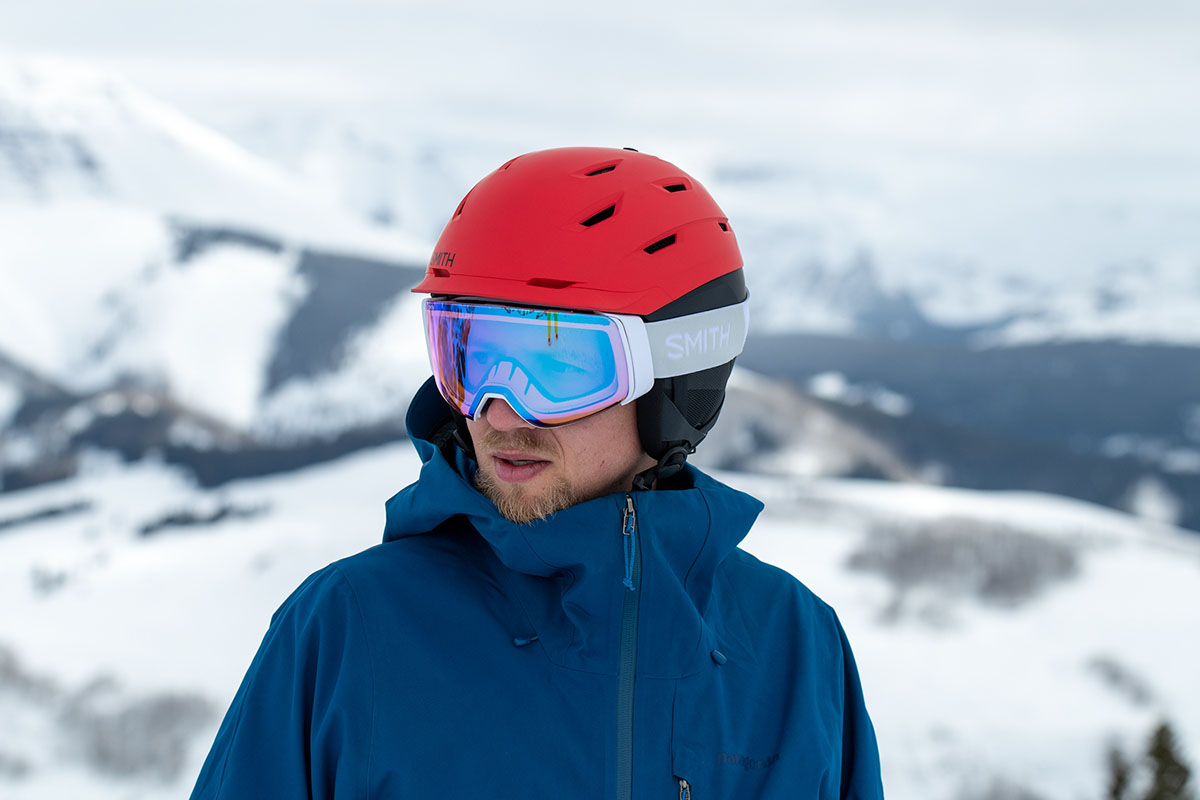

Price: $320-$350
Frame size: Medium/large
Number of lenses included: 2
What we like: Top-quality build with a noticeable boost in downward visibility.
What we don’t: Expensive and small amount of distortion at the curve in the lens.
See the Smith 4D Mag
Building on Smith’s popular I/O Mag snow goggle, the newer 4D Mag features a curved section at the bottom of the lens designed to greatly increase downward visibility. We tested the high-end goggle over a full ski season and found that while the added field of vision may be overkill for some, it’s yet another high-quality Smith product. The 4D is extremely user-friendly with a fast lens-change system and delivers standout optics, fog prevention, and comfort. Below we break down our full experience with the 4D Mag. To see how it stacks up to the competition, see our article on the best ski goggles.
The biggest news with Smith’s 4D Mag is the curve at the base of the lens called BirdsEye Vision, which significantly increases visibility straight down and in the corners (by a claimed 25%). It's hard to quantify, but in use, the difference was immediately noticeable. What previously required tilting my head back and down was now fully in view: It was noticeably easier to access my jacket’s chest pocket, adjust the sternum strap buckle on my pack, and verify all my pockets were zipped up. It's worth noting that the boost in visibility was most apparent while stationary—sitting on a lift or stopped mid-run—but in those situations, it easily beats out the competition.
In addition to the benefits of the curved lens, the 4D Mag's low-profile build delivers excellent overall field of vision. Peripheral visibility is more on-par with oversized designs like Oakley’s Flight Deck and Smith’s own Squad XL—impressive considering the Smith is only a medium/large fit goggle—and you can just barely see the frame at the base and top of the lens. That said, you certainly pay a premium for the added performance—it comes in $50 more than the I/O Mag, which offers similar visibility on all sides except the bottom. And to be fair, not everyone truly needs the added field of view. Most of the time on the hill, you’re looking out in front of you rather than directly downwards or in the bottom corners. But for those who prioritize unencumbered and comprehensive views, the 4D Mag is hard to beat.
Like most goggles in the $200+ price range, the 4D Mag comes with two premium lenses that can be swapped out depending on conditions. There are a range of ChromaPop options to choose from, but I opted for the Everyday Red Mirror (25% VLT), which also includes the Storm Yellow Flash low-light lens (65% VLT). Overall, like our previous experiences with Smith’s ChromaPop designs, both lenses provided fantastic clarity in a range of conditions both on and off trail. They do a nice job highlighting bumps even in shadows and have a very natural look and feel that’s almost HD-like.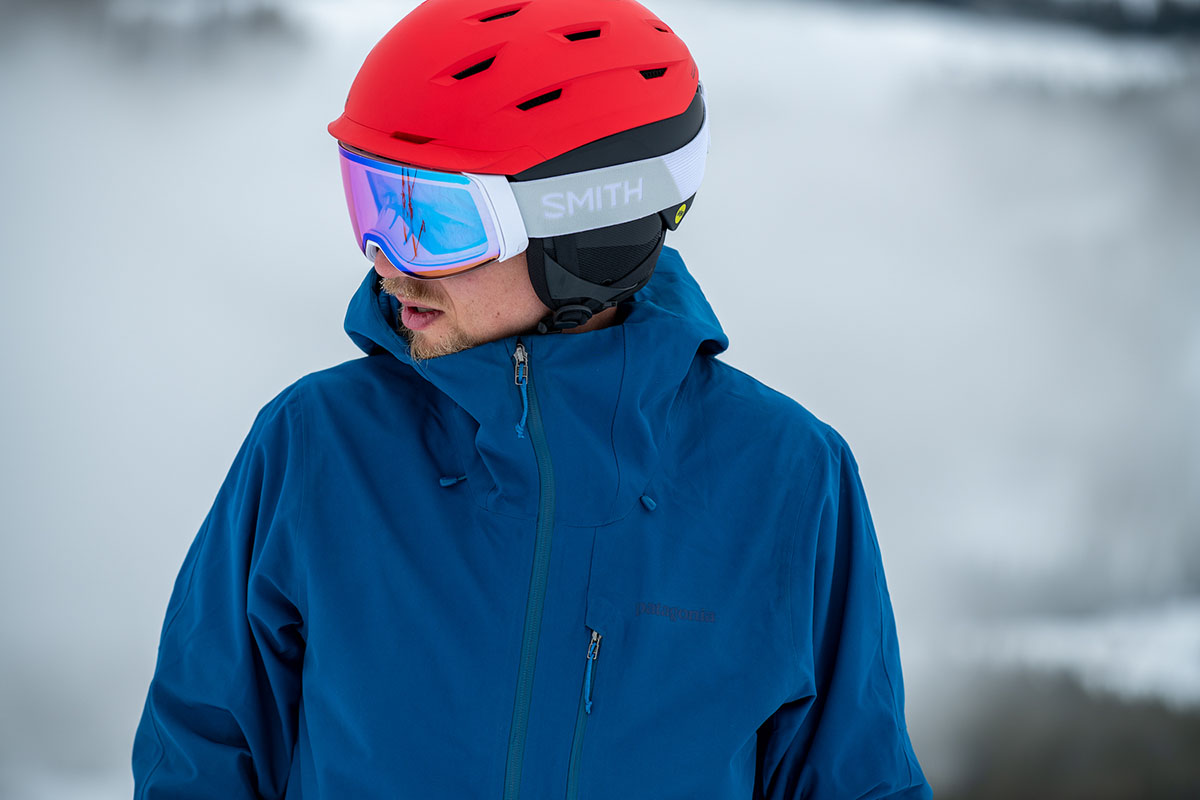
Conditions vary quite a bit at my local hill in central Washington: Early in the season, we get a lot of dark days with the sun tucked behind the mountain for long stretches, so the Storm Yellow Flash saw a lot of use. And it proved to be a great match, letting in ample light for skiing in the trees and on stormy days. As with all goggles we’ve tested, a whiteout is still a whiteout, and no fancy lens tech can fix that, but otherwise, the lens was excellent. It was also surprisingly versatile given its high VLT: Even when the sun popped out for stretches, it blocked just enough light (combined with the small bill on my Smith Level MIPS helmet) to keep me from wanting to swap to the mirrored lens.
On bluebird days and later in the year with more light on the hill, the Everyday Red Mirror similarly excelled. The mirrored finish cut down on glare, and everything was clear and precise. I did find it to be a little dark for cloudy days, even in mixed conditions, so riders in regions that are frequently socked-in will likely not utilize this lens often. On the other hand, those who live in areas with a lot of exposure and sunlight will find the Red Mirror to be their go-to.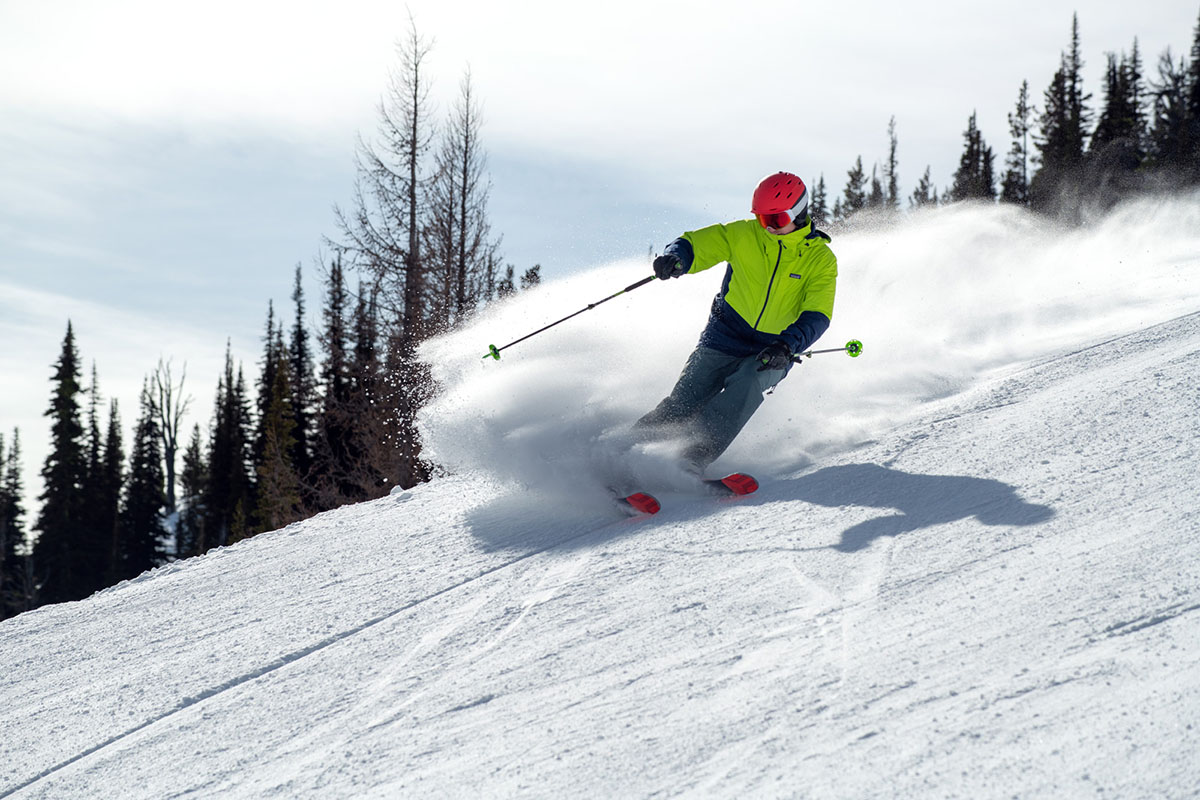
All that said, it’s worth noting that the 4D Mag’s curved lens does have a minor impact on overall optical quality. In the standard field of view above the curve, it’s quite similar to other ChromaPop lenses I’ve tested—including the I/O, I/O Mag, and Skyline goggles—but there is a faint but noticeable line and small amount of distortion right at the base of the lens where it bends. To be fair, however, it’s something I only noticed when first putting on the goggles in the day and when sedentary (such as on the lift), but it never negatively impacted my vision while skiing. In the end, most folks shouldn’t have an issue here.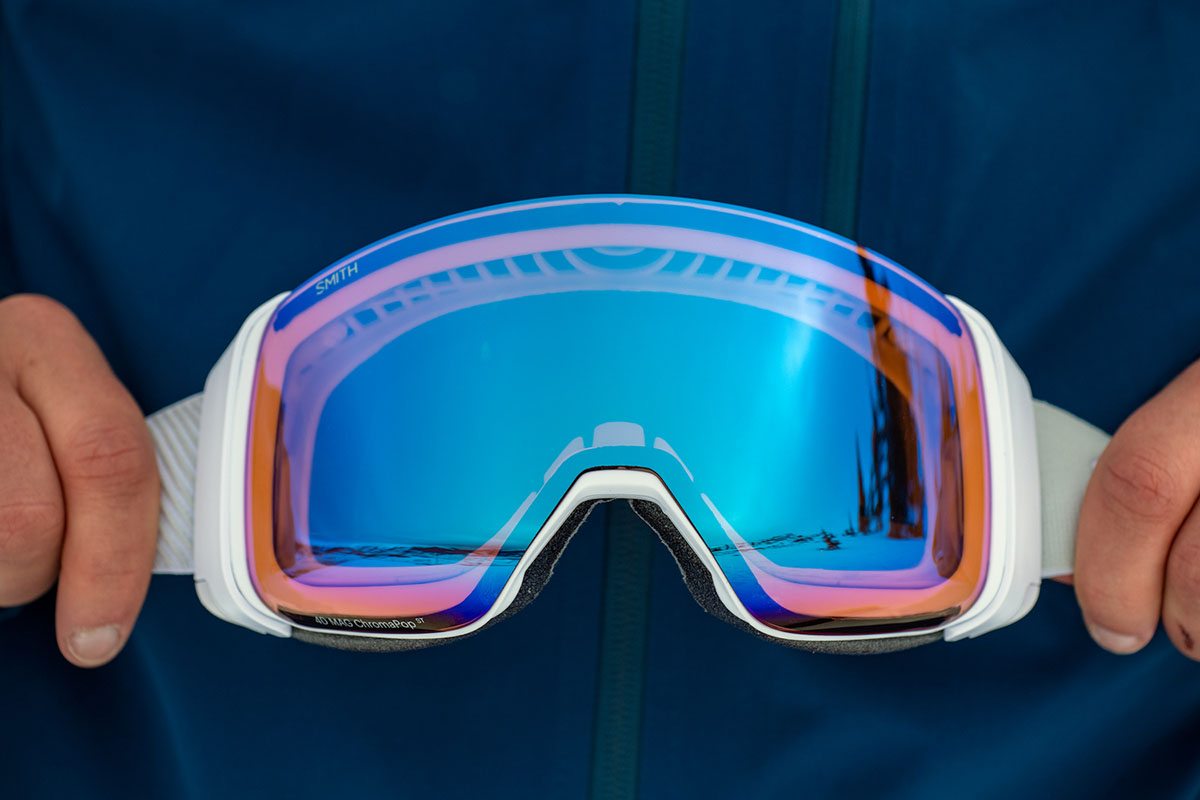
Improving on the Smith I/O Mag’s design, the 4D Mag offers one of the fastest and most user-friendly quick-change systems. Simply push the two small levers at the base of the frame open with your thumb (it’s easiest to do this without gloves on but workable with them) and then pull the lens away (it’s held in place in by six magnets). Reinstalling is just a matter of reversing the process, and the magnets pull the lens nicely into place. Once you get it down, swapping takes only around 10 seconds, so speed is not an issue.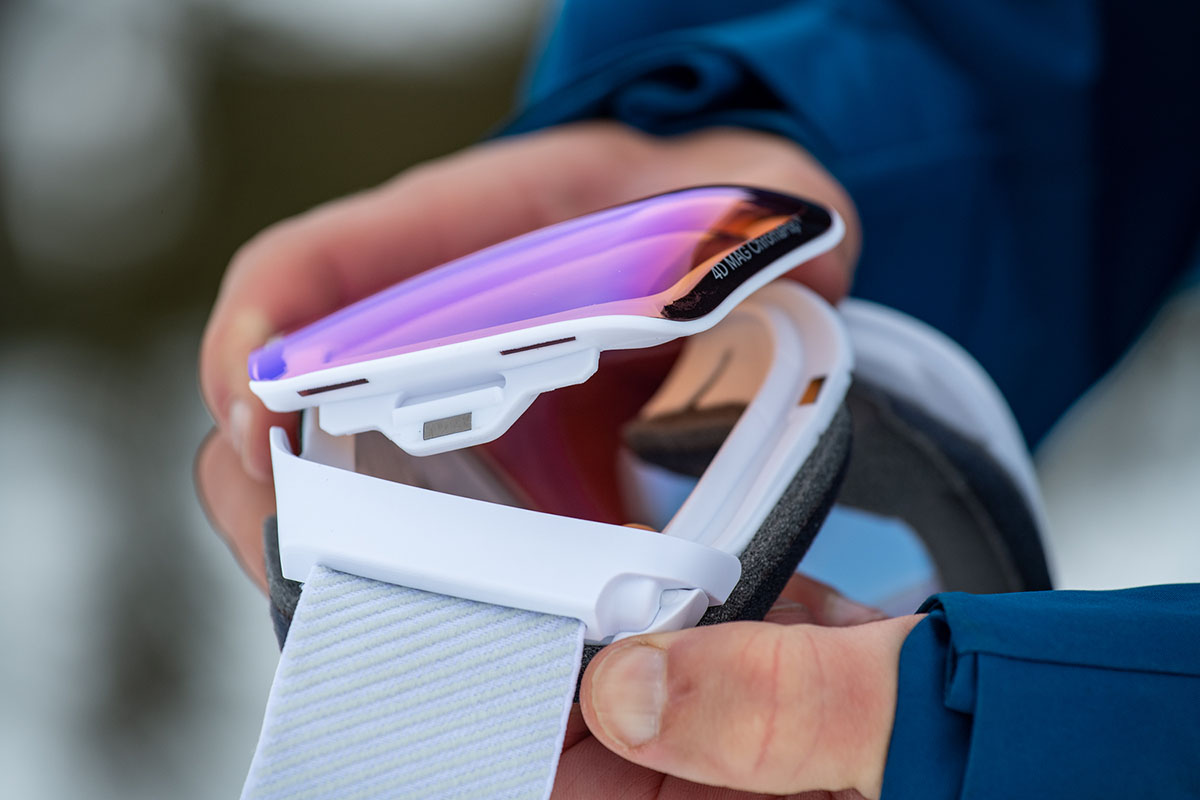
To be sure, the 4D’s design still can’t match the convenience of Anon’s magnetic system found on models like their M4 Toric MFI, which doesn’t have any levers and allows you to change lenses without having to remove the goggles. But Smith’s locking levers add a good dose of security to keep them in place in the event of a fall. In the end, it’s a tradeoff: while it’s tougher to quickly swap lenses on a lift—although we certainly did this on occasion with the Smith—the 4D Mag has a very well-rounded and reliable system. And a final note: It's pretty easy to change lenses out while only touching the frame, so you can avoid pesky smudges.
Simply put, Smith just seems to get fog prevention. The 4D Mag features a long-lasting coating along the interior that held up throughout a full season of use, and the only situation I experienced fogging was on extended sidecountry hikes (and this was very manageable). The top of the frame and a portion of the sides also have mesh-like openings that encourage airflow, although unlike the I/O Mag, there aren’t any along the bottom (the curved lens blocks this). Wearing it back-to-back with the I/O Mag, there is a bit less air movement, but it hasn’t translated to any performance issues. And as with all snow goggles, it does take some practice to get everything dialed in to limit condensation issues: Don’t overdress, don’t store the goggles wet or put them on top of your helmet, and pair them with a well-ventilated helmet (I wore the Smith Level MIPS for most of the season). With these precautions, the 4D Mag should do a great job staying clean and clear.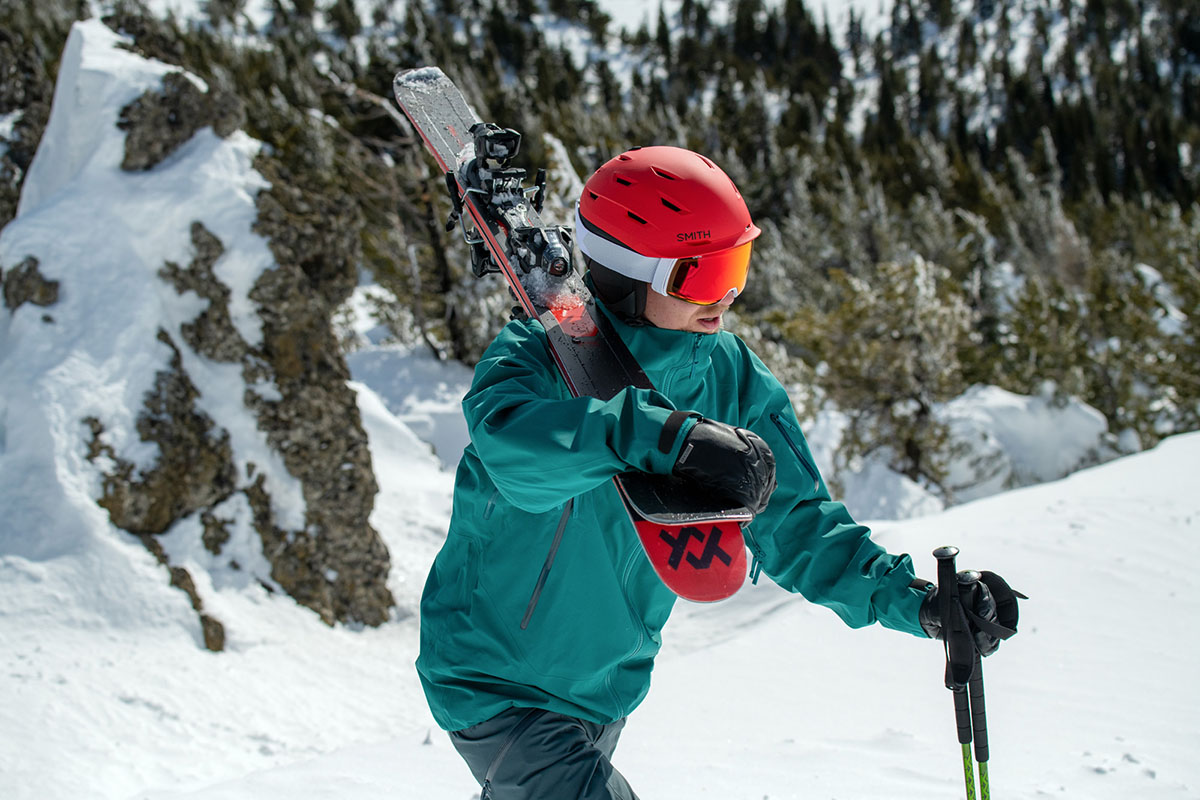
In my opinion, the Smith 4D Mag justifies its price tag with its high levels of comfort. I didn’t have any issues wearing the goggles all day: The triple-layer foam is super soft and does a nice job wicking moisture, and the frame is just flexible enough to mold nicely to your face. The goggle is listed as a medium fit, although I would say it runs on the slightly large end of the spectrum (we define it as a medium/large). I do prefer a medium size—the standard I/O Mag that I wore for most of the 2018/19 season was just about ideal—and the modest bump in form factor is noticeable. That said, I had no size-related complaints: My helmet didn’t push the goggle down onto my nose, and it never felt cumbersome or bulky (a problem I’ve had with large models like the Oakley Flight Deck). All in all, I would say the size is pretty versatile and should make most skiers happy.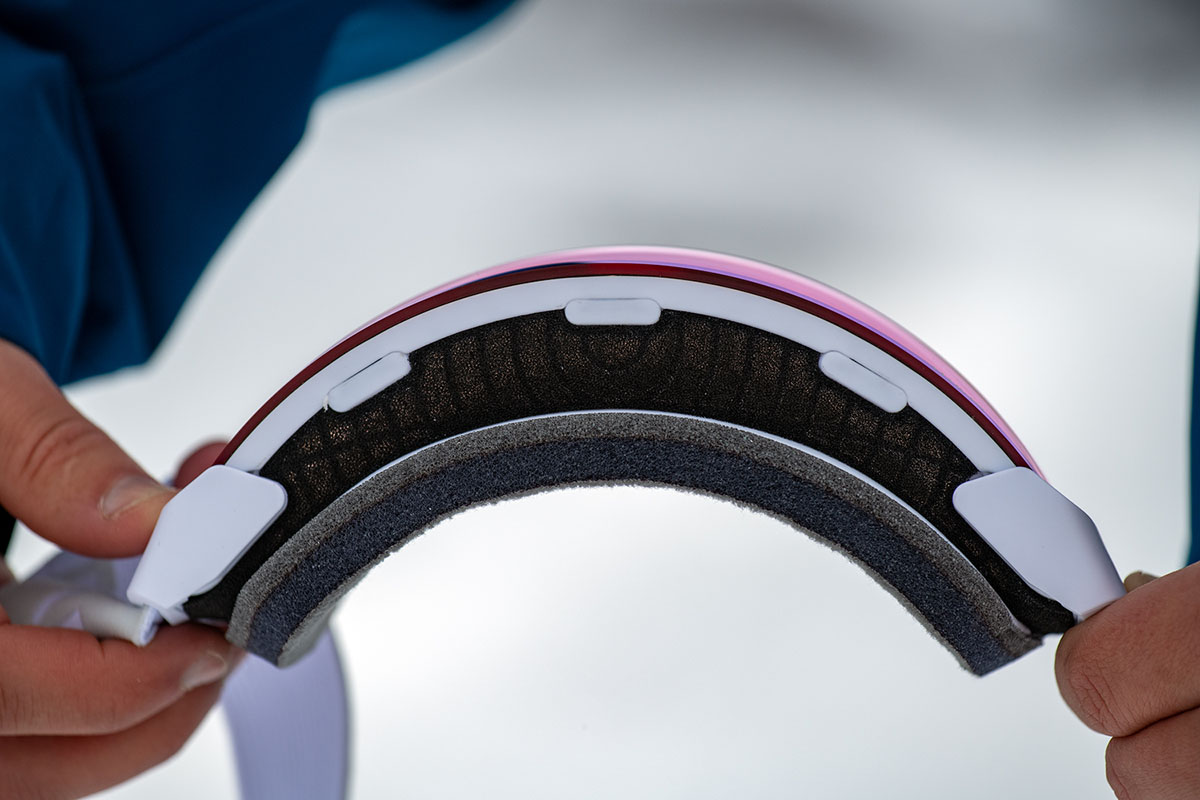
We set high expectations for a premium goggle, and the 4D Mag delivered for the most part. Outside of the aforementioned nitpick about the small amount of distortion at the base of the lens, it’s the full package of lens quality, an easy-to-use change system, top-end materials, and all-around performance. The frame is clearly well made, I haven’t picked up any scratches or damage on the lens through a full season of use, and the strap is free of any fraying or signs of wear. Finally, I really like the included hard-sided case, which is a notable omission with the $50-cheaper I/O Mag. Overall, it’s a quality item with dedicated and protected storage for the separate lens, some ventilation to avoid moisture buildup (although I always dry my goggle before storing it), and a sturdy shell that’s easy to trust and keeps everything safe and protected.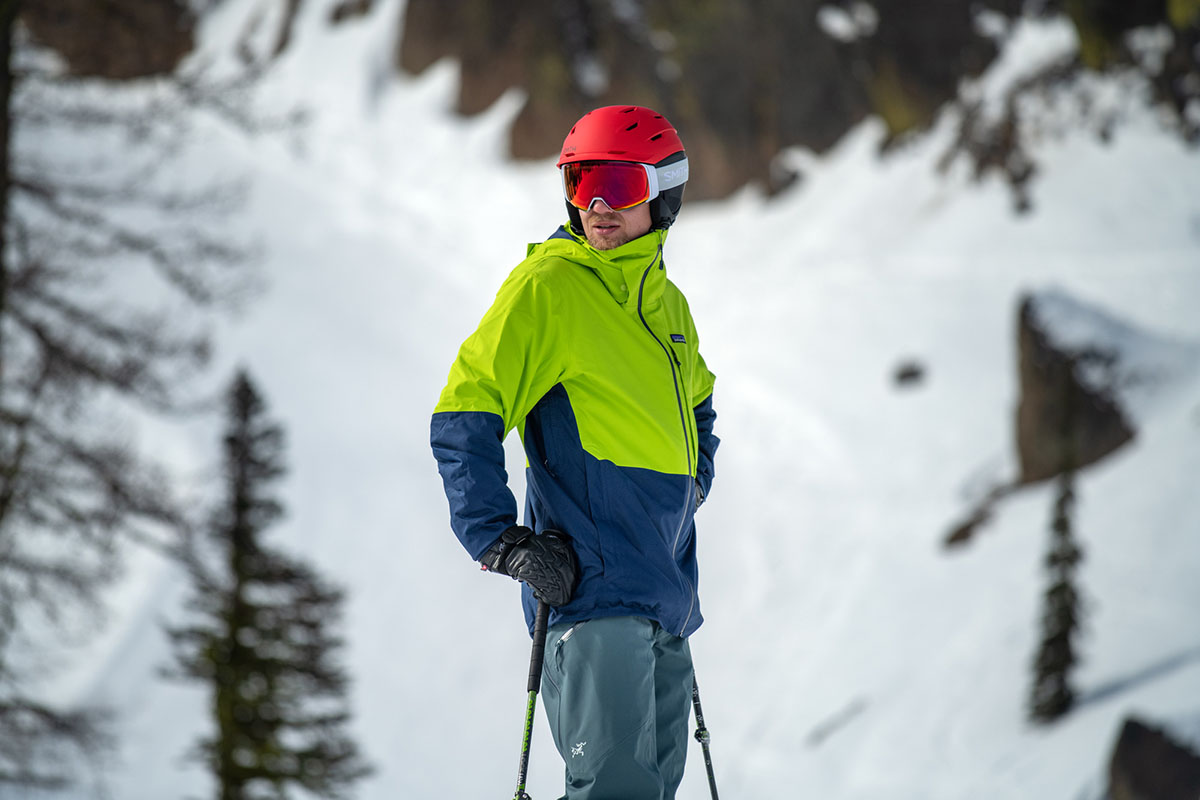
In addition to the standard medium/large fit goggle we tested for this review, Smith also sells the 4D Mag in a Low Bridge Fit variation. For those who try on the standard 4D and have a gap between their nose and foam of the goggle above, the 4D Mag Low Bridge Fit features extra lining at the bridge of the nose to create a better seal. Otherwise, all features remain the same, including the lever-based lens-change system, two ChromaPop lenses (although selection is more limited compared to the standard model), and comfortable three-layer construction. Finally, both the standard and Low Bridge Fit variations are available in Mag S models that are designed for smaller faces.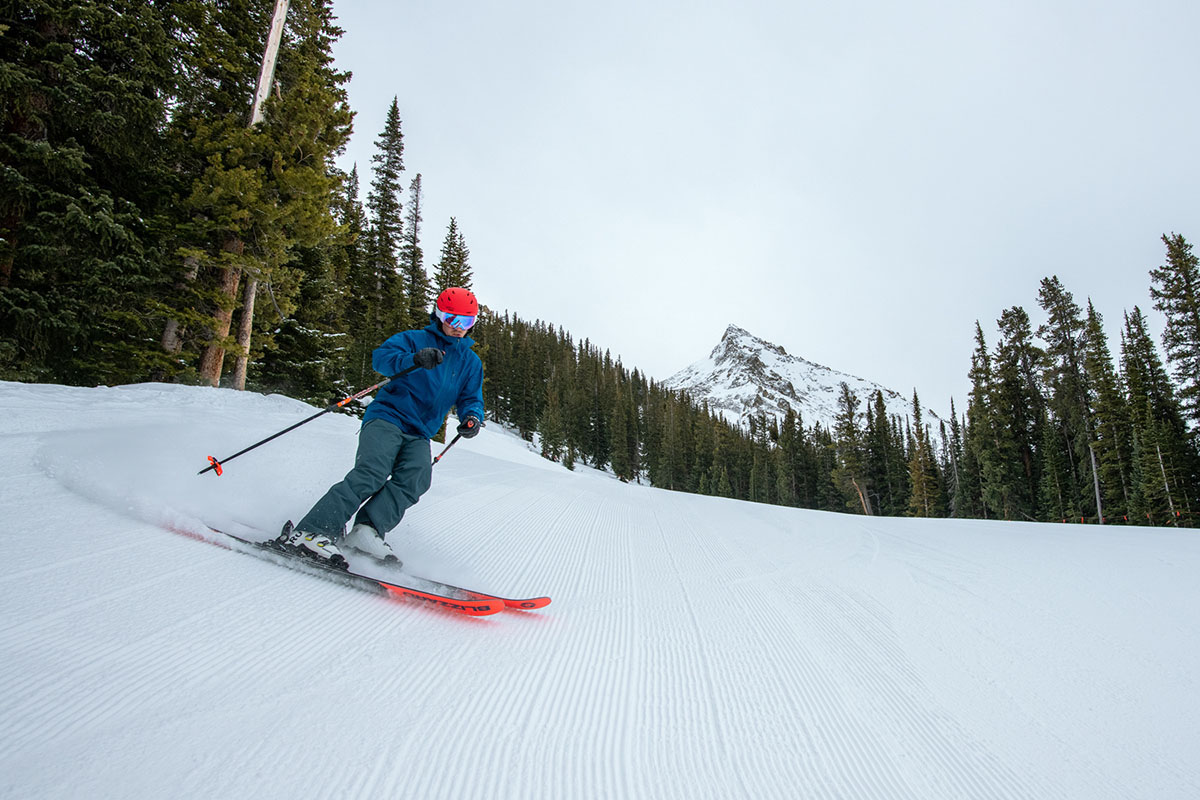
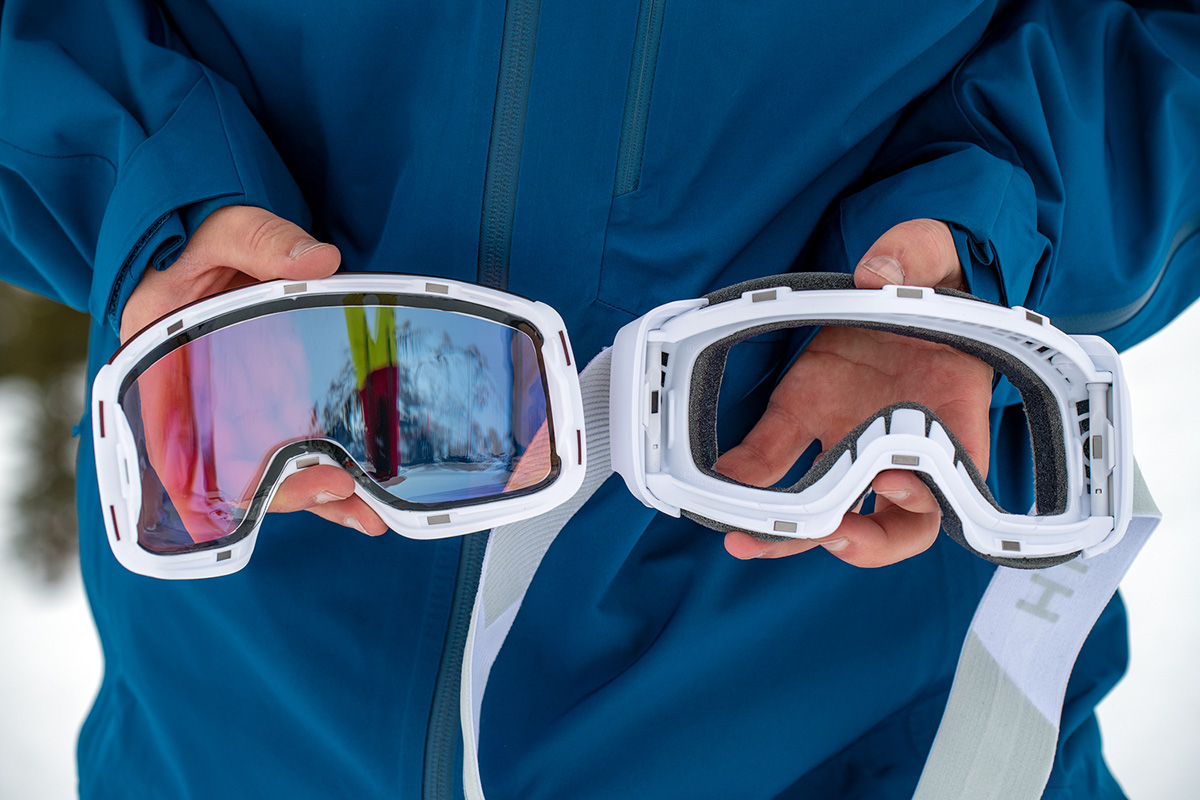
| Goggle | Price | Size | Lenses | Shape | Style | OTG* |
|---|---|---|---|---|---|---|
| Smith 4D Mag | $320-$350 | Medium/large | 2 | BirdsEye | Frameless | No |
| Smith I/O Mag | $270-$300 | Medium | 2 | Spherical | Frameless | Yes (I/O XL) |
| Anon M4 Toric MFI | $320 | Large | 2 | Toric | Framed | Yes |
| Giro Contact | $260 | Large | 2 | Spherical | Semi-frameless | No |
| Smith Squad Mag | $240-$270 | Medium/large | 2 | Cylindrical | Semi-frameless | No |
*Editor's note: OTG stands for "over the glasses" goggles, which fit over a pair of prescription glasses.
Smith’s 4D Mag was an exciting addition to the snow goggle market, and we’ve been impressed by its optical quality, high levels of comfort, and increase in downward vision. One of the 4D Mag’s closest competitors comes from within Smith’s own lineup: the popular I/O Mag. As we touched on above, the I/O Mag is a true medium fit, while the 4D is a bit bigger and more of a medium/large. Other differences include the curved lens on the 4D, which translates to significantly better downward visibility, and the larger shape gives it slightly improved vision all around. The quick-change system is also more user-friendly on the 4D—the levers on the I/O are more concealed behind the frame and a bit harder to use—but they’re both well designed and very secure. In the end, we still prefer the $50-cheaper I/O Mag, as not everyone needs the added field of view. But the 4D is a close alternative, and we do like the inclusion of the hard-sided storage case.
Another premium design to consider is Anon’s M4 Toric MFI. Stacked up against the 4D Mag, the Anon is a true “large” fit rather than the medium/large Smith, and we prefer the more natural color rendition of the 4D Mag’s ChromaPop lenses (although Anon’s lenses aren’t far behind). As we touched on above, Anon’s magnetic, quick-change lens system is a bit faster, but the Smith’s is more secure with levers that lock the lens in place. And finally, the M4 Toric comes with a magnetic clip-in facemask, but we found it to be lacking in structure and easily sucked into your mouth when breathing heavily. All in all, both are fantastic designs with great ventilation and field of view, and a final decision will likely come down to whether or not you value the 4D Mag’s downward visibility.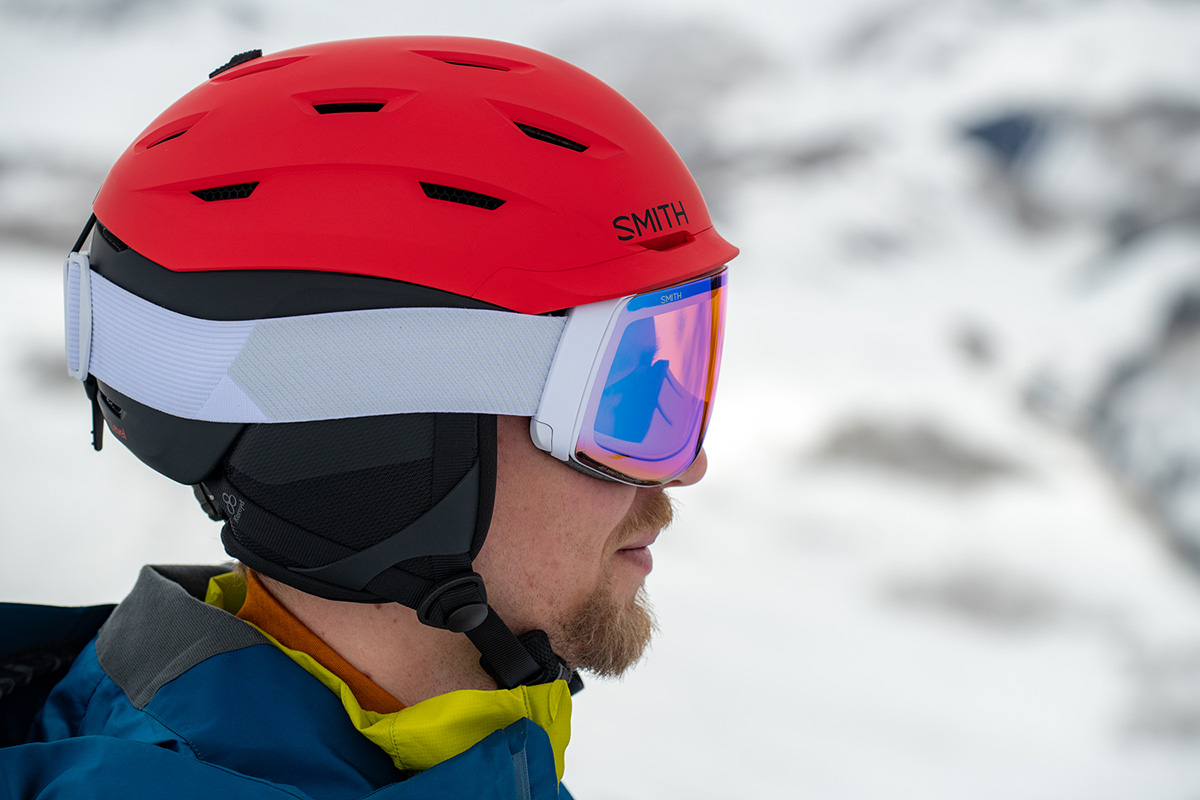
Giro is another big name in the snow goggle market, and their Contact goggle has been a popular option for years. Compared to the 4D Mag, the Contact’s lens-change system is a bit harder to use (the push button-style release is less intuitive than the Smith’s levers), and the Zeiss lenses are a small step down in all-around clarity and optical quality. Like the M4 Toric above, the Contact is also a large fit, which can feel more cumbersome on the face. For $60 more, we think the 4D Mag is the better all-around performer, even without the boost in downward visibility. And more recently, Giro released the Contour and Contour RS (short for “reduced size”), which have a sleeker frameless build, toric shape, and more intuitive magnetic lens-change system for $270 (although we still prefer Smith’s ChromaPop optics).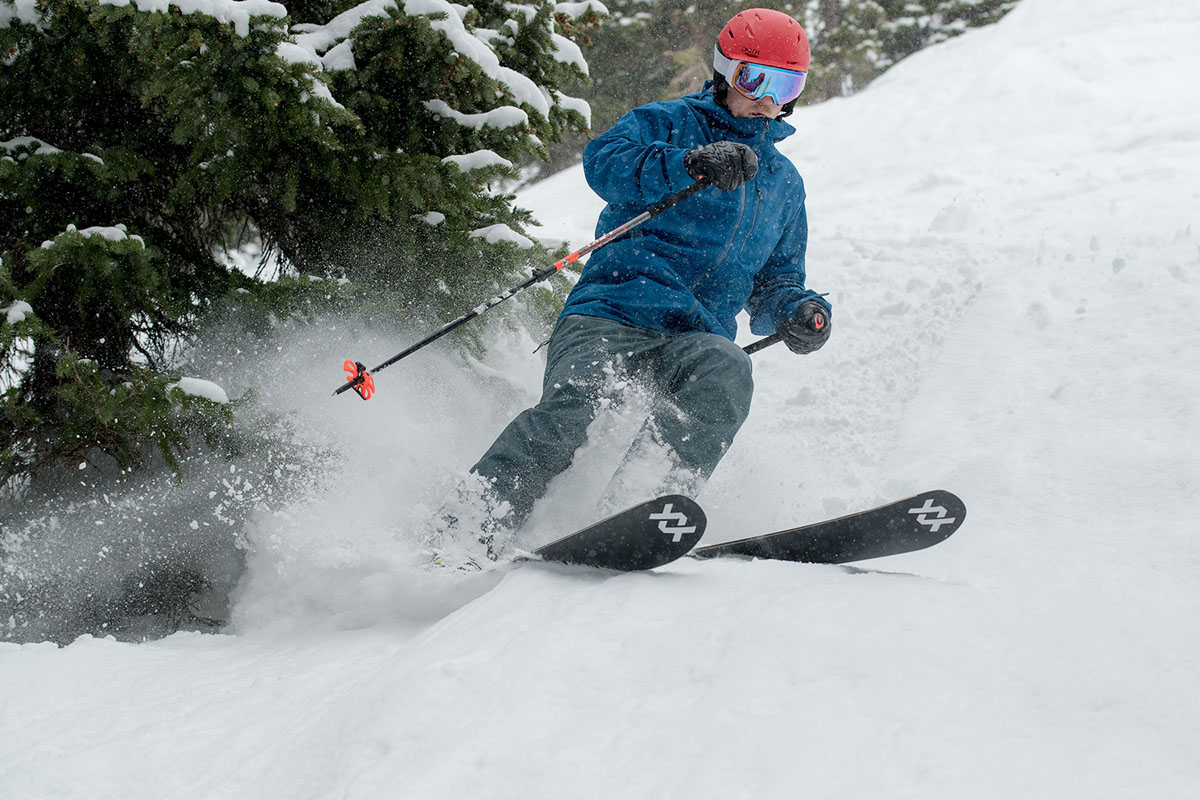
Smith’s own Squad Mag is a final competitor to have on your radar. Another addition in the growing “Mag” family of quick-change goggles, the Squad undercuts the 4D Mag in price by $80 due to its cylindrical lens but otherwise shares a lot in common: It uses similar levers along the outside of the frame for swapping lenses, utilizes triple-layer foam for comfort, comes with two ChromaPop lenses, has a medium/large fit, and offers great ventilation. Field of view is the biggest sacrifice—it even falls short of the I/O Mag—and the optics are also a small step down from the 4D Mag, but the Squad is still a solid option and should be more than serviceable for most riders (for more, see our in-depth Squad Mag review).